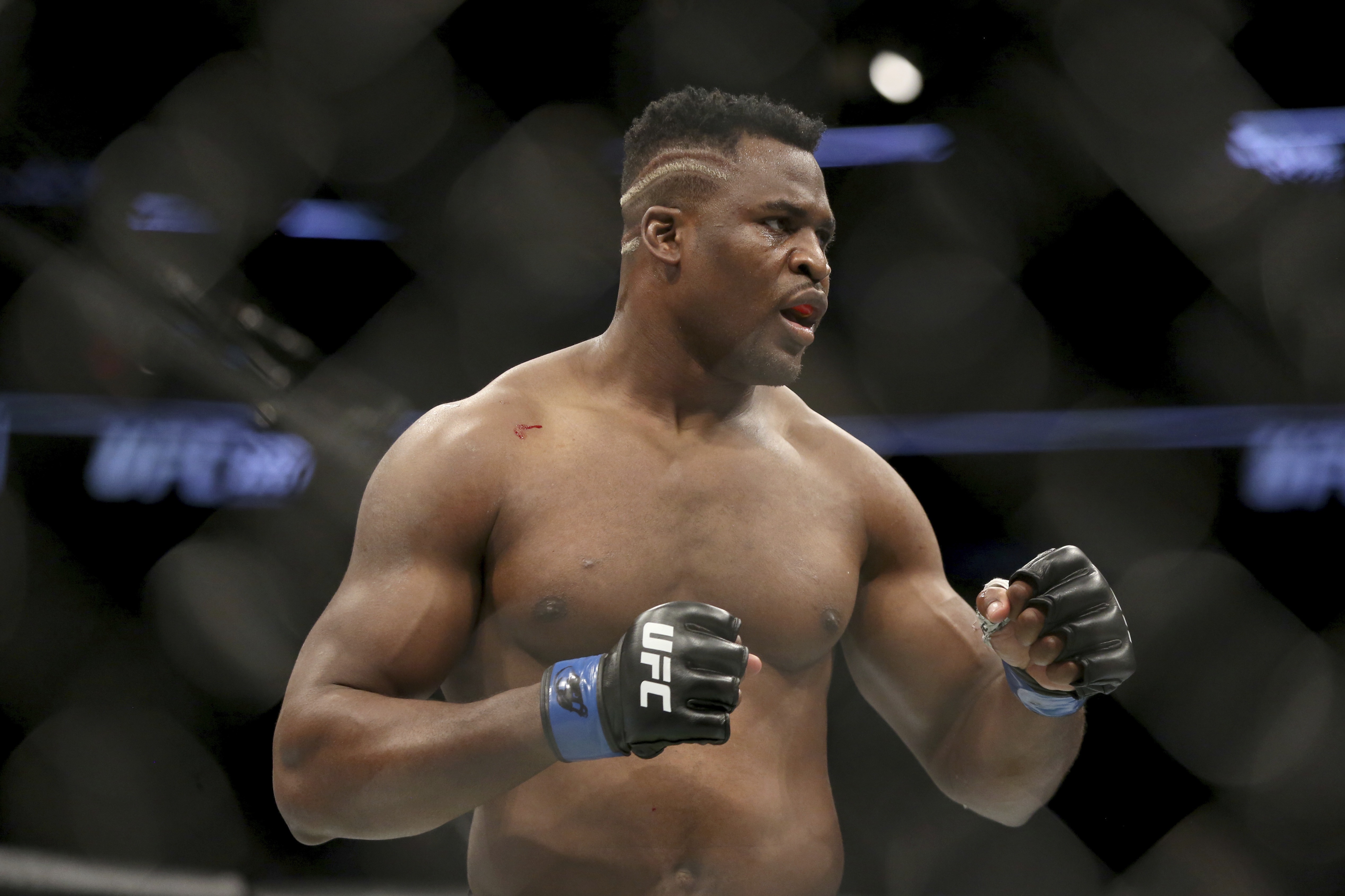JAKE PAUL has revealed that Francis Ngannou will be earning far more for fighting Tyson Fury than the rumoured sum of $8million (£6.1m).
It was confirmed this week that the former UFC heavyweight champion would be facing the Gypsy King in Saudi Arabia on October 28.
Jake Paul has lifted the lid on Francis Ngannou’s true fight purse

Ngannou is set to fight Tyson Fury on October 28
The pair will fight for ten rounds under Queensberry rules – with Fury’s heavyweight belts NOT on the line.
Following the official announcement, it was rumoured that Ngannou would be earning $8m for the bout.
But Paul has clarified that this figure is way off – and that is merely what he’d been offered by the UFC, before he ditched Dana White’s promotion.
The Problem Child, like Ngannou, is signed to PFL’s Super Fight Division.
He has also fought in Saudi Arabia this year, losing to Tommy Fury in February.
Addressing rumours surrounding Ngannou’s purse, Paul tweeted: “Francis got eight figures. Not $8million. Get it right.”
The 26-year-old then added: “To all the Twitter geniuses: eight figures = $10,000,000+ and Francis deserves every bit of it.”
White, 53, has called Ngannou vs Fury a “gimmick fight”.
CASINO SPECIAL – BEST ONLINE CASINOS FOR 2023

Fury’s belts will NOT be on the line against Ngannou
After securing the biggest payday of his career, Ngannou cheekily set up his own company, calling it “GIMIK Fight Promotions”.
Appearing on Sirius XM, the 36-year-old said: “For some reason, I always prove Dana White wrong – even when he’s on my side. I always prove him wrong, every single time. This is just our story.
“They were ready to do Jon Jones and Tyson Fury in MMA – why couldn’t they do Ngannou and Fury in boxing? I don’t know. I think [he] did that to try to take the fight away from me, and Dana did send out a contract [for the Jones fight].
“He sent out the contract, which I think was very embarrassing because that contract was rejected, and he signed mine for the GIMIK Fight Promotions.
“It’s not a secret that so many people wanted me to fail. They don’t want me to succeed, it’s not a secret, it’s quite obvious, and you all know about it.”

Frequently Asked Questions
How many punches is a human capable of taking?
A punch can be defined as “a blow delivered with a fist”. One punch is all that a human can take. If someone punches your face in the face, it’s a punch. You cannot hit him/her back. That would be two punches.
What are the health benefits of boxing
There are many health benefits associated with boxing. For starters, boxing helps build strong muscles and bones. It enhances your coordination as well as reflexes. It also strengthens the heart and lungs. Boxing doesn’t need any special equipment. You can use whatever you have around the house.
How can I practice boxing without a partner?
You can also watch professional boxing matches live on TV if you don’t have a partner and want to learn boxing. You can also find an amateur boxing gym near you. Amateur boxing groups often have regular training sessions. These sessions typically include sparring partners that hit pads together.
Punching bags are another option for practicing boxing. Before you hit the bag, make sure to wear protective gear like boxing gloves.
How can I increase my defense against fighting?
Learning how to fight intelligently can help you improve your defense. You need to know how defense against attacks from every angle is possible, as well how to counterattack in case of emergency.
If you don’t know how to fight, then you won’t be prepared for anything. You’ll just get beaten up. If you know how to fight you will be ready for anything.
Here are some tips to help you improve your defense:
- You need to know where your opponent is coming from. This means you must pay close attention to the body language of your opponent. This could be a sign that your opponent is preparing for his next attack.
- Keep your cool. Don’t panic. Instead, remain calm and focused.
- Block with your arms. You can defend yourself against attacks by blocking with your arms.
- Counterattack. You should immediately counterattack your opponent if they are attacking you.
- Fight dirty. Fight dirty. You can also respond to an opponent’s kicks by kicking them back.
Statistics
- You want to be running at roughly 75-80% of your top speed..5 mile slow, easy recovery jog at the end.[6]X Research source 2Mix in long runs, shadow boxing, and short sprints on non-interval days. (wikihow.com)
- This article received 39 testimonials and 89% of readers who voted found it helpful, earning it our reader-approved status. (wikihow.com)
External Links
expertboxing.com
en.wikipedia.org
How To
These are the basic skills of boxing
How to box efficiently
Boxing is one the most well-known sports in the world. It is a fight between two opponents. Different countries have different rules. There are three main types of boxing: Amateur boxing, Professional boxing, and Olympic boxing.
Amateur boxing may be done at school, college, and university. This form of boxing involves sparring with no protection and using padded gloves. Usually amateur boxing competitions consist of three rounds of five minutes each. There are many styles of amateur boxing such as Kickboxing or Muay Thai, Taekwondo and Karate, Judo and Wrestling, among others.
Boxing professionals are usually trained in clubs, gyms, or stadiums. They have protective equipment such as mouthpieces. Professional boxing competitions consist of six rounds lasting four minutes each. There are many types of professional boxing. These include Boxing (MMA), Kickboxing (Mixed Martial Arts), Muay Thai and Taekwondo.
Olympic boxing is performed at the Olympics. Boxers wear special protective gear, which must conform to international standards. Each round lasts three minutes and is made up of eight rounds. Only two types of Olympic boxing are available: Light Flyweight or Heavyweight.
The basics of boxing are:
- Punching techniques
- Techniques for protecting yourself
- Footwork
- Stance
- Body movement
- Defense
- Combination
- Rotation
- Spare parts
Punching Techniques
There are seven types: Left Hook (right hook), Right Hook (uppercut), Cross (cross), Straight, Overhand, Underhand. Each punch is different. Some punches require more force than others. An uppercut, for instance, requires tremendous strength. A straight punch on the other side requires less power, but is more effective than other punches.
There are many combinations of punches. These are combinations that combine punches to accomplish a particular goal. A combination can contain multiple parts. An example of this is a left hook, followed by a right crossing. This will damage the opponent’s jaw.
Guard Techniques
A boxer protects himself by using his body. He uses his arms, legs, elbows, knees, knees, and feet to do this.
Legs
A boxer must use his legs to defend against kicks. When he receives a kick, he raises his leg and moves away from the attacker. If the attack comes from the front, then he bends his knees to avoid being kicked on the side. If the attack is from the side, he will bend his knees to avoid being kicked on the side.
Elbows
Because elbow strikes inflict a lot of pain, they are very effective. You can either deliver an elbow strike directly, or indirectly. Directly means you hit your opponent directly with your forearm. While indirectly, it means you hit him with another section of your arm.
Hands
Boxers use their hands as a shield against incoming punches. To do so, they raise their fists above their head and move them towards the direction of the attack. The attacker’s fist is then in their face.
Knees
A boxer should bend his knees in order to absorb any blows to his stomach, abdomen, chest or stomach. Defense purposes are often served by knee strikes.
Feet
A boxer should not be afraid to respond to an attack. This will allow him to gain distance from his opponent. Also, boxers must maintain their balance while delivering counter-attacks.
Stances
Boxing is only possible if a boxer has a clear stance. How he defends his self will depend on how he stances. It is how he positions himself and where he faces the opponent. Boxers can take many different stances. Here are some of the more popular ones:
- Low stance
- High stance
- Southpaw stance
- Western stance
Moving your body
A boxer must change his position, speed and rhythm in order to win the fight. This involves changing positions, speed, rhythm and timing.
Rotation
Rotating his arm to increase the puncher’s reach is a key part of boxing. The rotation is done at different speeds depending on the type of punch.
Combinations
The effectiveness of a combination depends on the timing of each individual punch. A combination that is effective starts with a strong punch, and ends with one that is weak.
Spare parts
Sparring is an exercise session to improve boxing skills. A sparring session is where a boxer trains both his mind and his body. The goal of sparring is to learn to fight, and not to get hurt.
It is important to be patient and dedicated when learning how to box. Boxing is a sport that requires dedication and perseverance.

